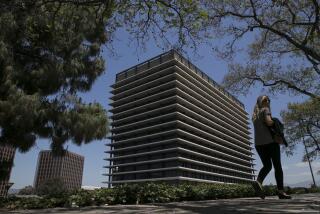DWP Board Votes to Seek Hikes in Water, Power Rates
The Los Angeles Water and Power Commission voted Tuesday to seek an 11% increase in water rates and to double an emergency surcharge to cover part of a projected $98.8-million deficit caused by the five-year drought.
The two rate hikes, if approved by the City Council and mayor, would raise about $22.8 million for the Department of Water and Power in the current fiscal year.
But the average homeowner’s bill would remain essentially unchanged at about $22.90 a month because of a quirk in accounting and the current high level of conservation by DWP customers, according to the city administrative officer.
“The proposal will keep us financially whole but not penalize customers that have done a good job of conserving,” said DWP General Manager Dan Waters.
Officials said the projected deficit was brought on by a 30% drop in water sales and increased costs of the city’s conservation effort. Similar problems have beset other water agencies including the Metropolitan Water District, which is considering an increase of up to 88%.
The DWP commissioners approved the rate increase only after the DWP staff made more than $45 million in budget cuts to reduce the deficit.
“Any more cuts will seriously affect our ability to deliver water,” said Mike Gage, president of the DWP board of commissioners, which unanimously approved the proposal. “It will cost us more in the long run if we don’t” spend the funds necessary to maintain the city’s vast water system, Gage said.
The commissioners also approved a 7% increase in electric rates. The increase would raise about $55 million annually, increasing average monthly electric bills by about $2.90, to $43.60. It would be the first power rate increase since 1988.
But the water increase has received more criticism because it comes as customers have been required to cut their consumption--and have responded with a 30% reduction in water use.
“It’s an outrage,” said City Councilwoman Joy Picus. “I can’t believe the DWP commissioners could be so insensitive. The people cut back and now they are being punished.”
Picus has vowed to fight the increase until the DWP can demonstrate that it has pared its budget to the bone. “The DWP has always been fat and sassy. Until it’s lean and mean, I won’t support an increase,” Picus said.
Despite protestations by Picus and others, Gage predicted that the measure will be approved by the City Council. “This is not an outrageous rate increase,” he said.
City Administrative Officer Keith Comrie, in a report to the mayor on Tuesday, recommended that the rates be approved. “It reflects (DWP) management’s best efforts to maintain the integrity of the system . . . and to keep expenditures to the absolute minimum,” he wrote.
Chief Legislative Analyst William McCarley said he concurred with Comrie’s findings and will recommend that the council approve the rate requests.
Mayor Tom Bradley, who is in Asia on city business, has not taken a position on the rate hikes.
But John Stodder, his adviser on water and environmental matters, said, “The mayor hopes (the City Council) will take a sober and analytical look and keep emotion out of it. We need to look at the fiscal integrity of (the DWP) and the environmental goals of the city.”
Comrie said the unexpectedly high level of water conservation also is leading to fiscal problems for Los Angeles’ sewer system, which he projected will have a $54-million deficit this year.
Sewer rates are based on water usage. But city residents have cut their usage by 30%--twice as much as officials projected when they set sewer rates, Comrie said in his report to the mayor.
Under the proposal approved by DWP commissioners, the basic water charge would increase by 11%. In addition, the drought surcharge of 9 cents per billing unit would be doubled to 18 cents, until officials declare an end to the drought.
The surcharge is designed to compensate for the reduced volume of sales caused by the drought and the city’s mandatory 15% rationing program. A billing unit is 100 cubic feet of water, or 748 gallons. The average residence uses about 18 billing units a month.
Residents are required to cut their use by 15% from 1986 levels. But since the program began in March, consumers have about doubled the rate. That cutback reduced DWP water revenues by about $70 million.
At the same time, the expenses of operating the aqueducts and pipelines changed little, despite the reduced volume of water sold.
In addition, special conservation programs have added to expenses. A program to offer customers $100 rebates for installing low-flow toilets exceed the projected $2-million budget tenfold--reaching $20 million by the time it was canceled on Tuesday.
The department also spent millions on scores of “drought busters” who cruised the city looking for violations of the city drought emergency ordinance and distributing educational materials. The DWP has laid off about half of the drought busters as part of its budget cuts.
Officials said monthly water bills will remain essentially unchanged despite the rate increase because surcharges for special purchases of water from the Metropolitan Water District have fallen to zero in recent months and are expected to remain low through the end of the year.
The elimination of surcharges for the MWD water--which at times has supplied as much as 60% of DWP’s water--will offset the rate hike, officials said.
More to Read
Sign up for Essential California
The most important California stories and recommendations in your inbox every morning.
You may occasionally receive promotional content from the Los Angeles Times.










